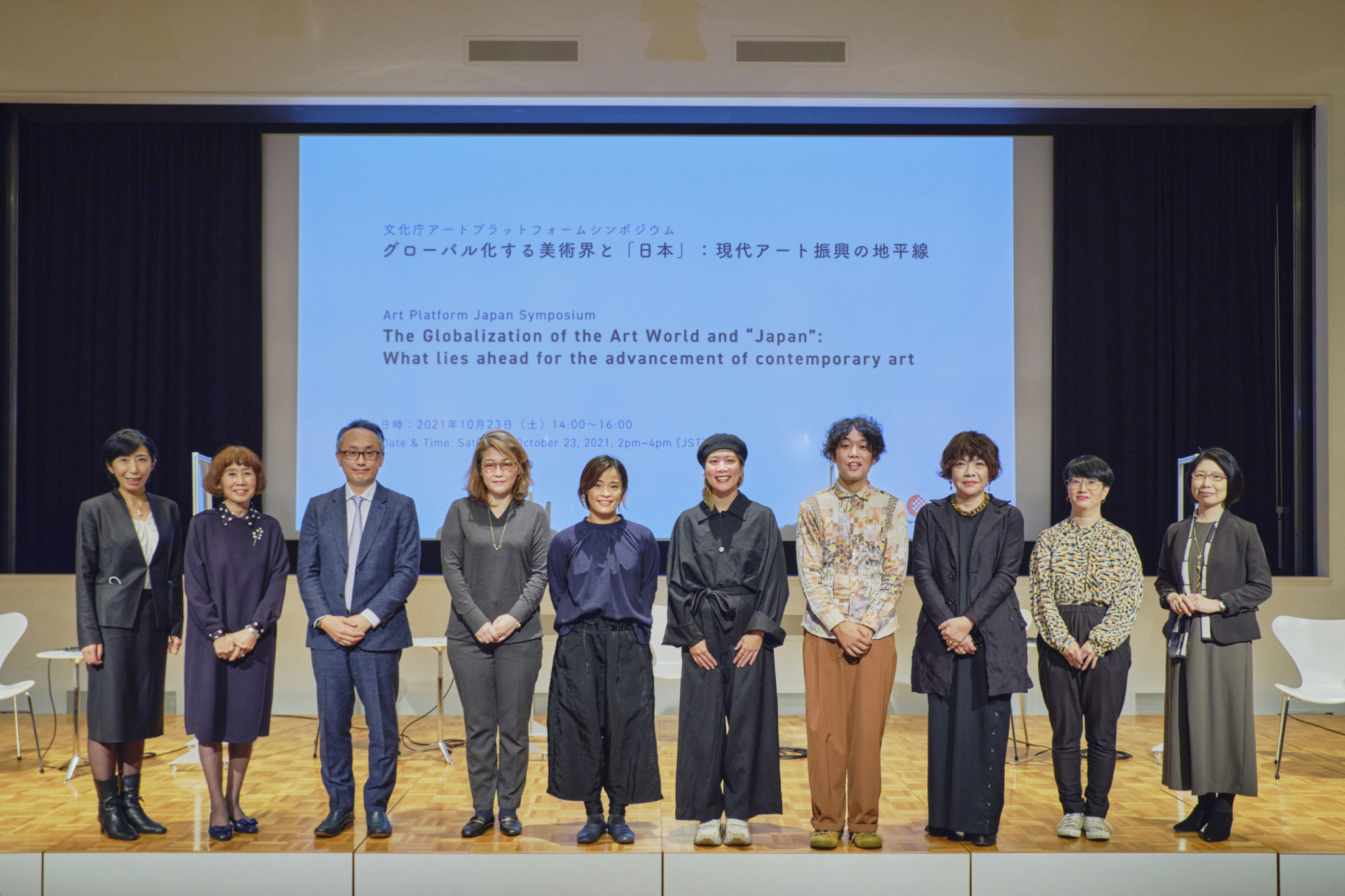Art writer and editor. She also works as an art coordinator in many exhibitions and projects. The editorial staff of RealTokyo.
Photographed by Kozo Kaneda
Bunka-cho Art Platform Japan was launched in 2018 as a five-year program for the creation of a framework for sustainable international exchange and networking, with an aim to raise the international profile and promote a greater understanding of Japanese contemporary art. This year’s symposium, “What lies ahead for the advancement of contemporary art,” was convened as a forum for the presentation of an interim report on the program’s main activities, as well as a broad discussion on matters of cultural promotion and international communication in Japan, against the backdrop of global change precipitated by the ongoing COVID-19 pandemic.
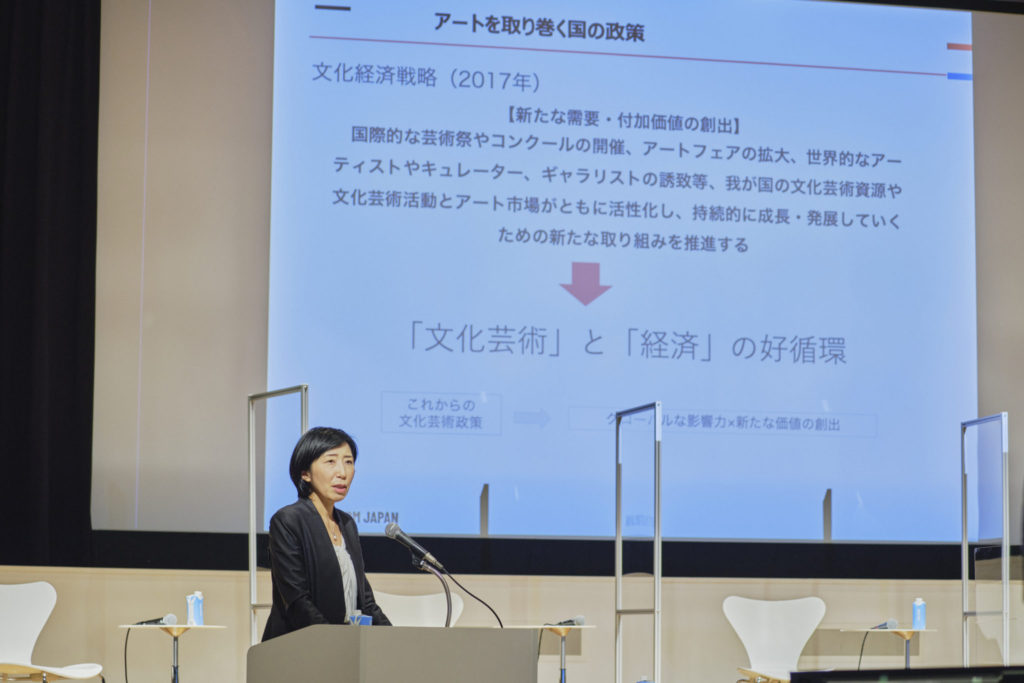
Photographed by Kozo Kaneda
Keynote lecture: What lies ahead for the advancement of contemporary art: Entering a new age of art
Hirayama Naoko (Director, Planning and Coordination Division of the Agency for Cultural Affairs)
With an eye to its upcoming relocation to Kyoto in 2022, the Bunka-cho (Agency of Cultural Affairs, Government of Japan) has begun to consider the formulation of a new cultural policy. Hirayama Naoko, director of the Planning and Coordination Division of the Agency for Cultural Affairs, opened her keynote lecture with a review of previous cultural policies in Japan in the context of the international community, and suggested that it was time to reconsider the essential effects of art policies in Japan, and work out new policies for art and culture.
“Up to now, the Bunka-cho’s art promotion policies have focused on the establishment of a number of national art museums, and the creation of opportunities for viewing and exhibiting works of art. However, in today’s global society, it will next be necessary for the Bunka-cho to spearhead a new cultural policy gravitating around an evaluation of the merits of Japanese art and culture, informed by the perceptions and profile of Japan on the global stage, as well as the new value being generated as a result.” (Hirayama)
This will be achieved through “a virtuous cycle of culture and economy,” a roadmap that envisions the revitalization of both the art market and the promotion of artistic and cultural activities as a means to stimulate economic activity and social development across Japan, thereby further elevating Japan’s standing in the international community. It also dovetails with the “virtuous cycle of growth and distribution” and “new capitalism” policies put forward by the Kishida Cabinet. Regarding the importance of cultural and economic strategies, Hirayama noted: “Japan is, after all, a technology-oriented nation. As AI takes over technology, human creativity will become increasingly pivotal in ways that will also relate to economic policy. The idea is to invest in fields that rely on human involvement, and therefore give art a central role in Japanese policy at large.”
Infrastructure based on a general view
In a global context, the art market in Japan is very small. According to a survey conducted by Art Basel and UBS in 2020, the US, UK, and China accounted for more than 80% of the worldwide art market in 2019, whereas Japan’s art market amounted to less than 1% of the global share (according to The Art Market 2020). As one factor behind this rather low profile, Hirayama pointed out that the key players in the Japanese art scene have been working in disparate directions.
“One characteristic feature of Japan that’s not limited to the art scene alone is the nation’s great number and variety of small and mid-sized players that can demonstrate big power as a group. But in order to raise the profile of Japan as a whole, we need to set up an infrastructure that fosters greater cooperation and cohesion among the various key players in the domestic art scene—artists, gallerists, curators and collectors alike.” (Hirayama)
In recognition of the need for such a cultural policy across the board of conventional measures, an additional budget of 1.1 billion yen was recently earmarked for the establishment of a stewarding institution, tentatively named the Art Communication Center (budget for FY 2021 and third revised budget for FY 2020). The Art Communication Center will function as a lateral tie that holds all Japanese art museums together, while engaging in activities to bolster the respective museums’ plentiful collections as national art collections. Further tasks include the training of curators and the establishment of international networks, and the continued basic maintenance activities of Art Platform Japan. The Art Communication Center will be established within the National Art Center, Tokyo, also as a measure to enhance the function of the Independent Administrative Institution National Museum of Art as a whole. This marks a major turning point for the National Art Center, which has been playing a leading role as a venue for koubo-ten, general public exhibitions and large-scale exhibitions hosted by newspapers.
Supporting international art fairs
The current reconsiderations also focus on activities that require support. To date, the Bunka-cho has been putting effort into the support of international exhibitions and art festivals held in Japan, but going forward, will also place more of an emphasis on international art fairs, from the perspective of the “virtuous cycle of culture and economy.” Hirayama commented that “many Japanese art festivals have the atmosphere of a very local festival, and even though they attract considerable numbers of visitors, they don’t really inspire international communication. International art fairs function not only as occasions for boosting the trade of artwork, but also as platforms for artists to exhibit their work. This potency is something that the Bunka-cho wants to push as well.” She is confident that the Bunka-cho’s support of Art Week Tokyo, which took place in November with cooperation from Art Basel and the Contemporary Art Dealers Association Nippon (CADAN), marks a significant step in this direction.
“One of the agency’s central roles is to back privately-initiated activities, in order to amplify them into larger movements. I hope that both the public and private sectors will collaborate with us on big policies with a big impact, in the service of our shared common goal.”
One of the Bunka-cho’s medium to long-term goals is to “create places in Japan where artists and related professionals from around the world can come together.” The keynote lecture underscored this lofty goal and evinced the Bunka-cho’s commitment to a change of course toward a unified Japanese cultural policy.
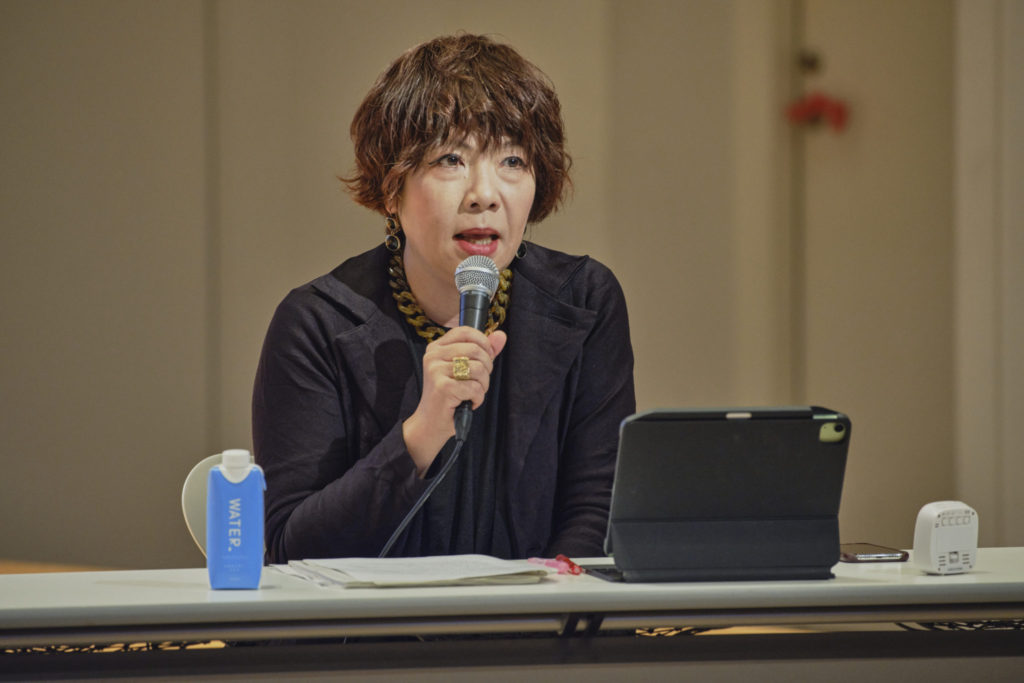
Photographed by Kozo Kaneda
Session 1: Art Platform Japan: Connecting Contemporary Japanese Art to the Rest of the World
Kataoka Mami (Director of the Mori Art Museum, Chair of the Contemporary Art Committee Japan)
Kataoka Mami, the Chair of the Contemporary Art Committee Japan that functions as a steering committee for Art Platform Japan, next explained the state of the enlarged global contemporary art scene, and the tough position that Japan occupies within this context.
Since the 1990s, globalization has progressed rapidly in all reaches of the world. The intervening three decades have seen a dramatic paradigm shift away from the former status quo, in which “non-Western countries demanded contemporary art supplied by Western countries.” Today, the worldwide contemporary art scene has expanded to the point of saturation, with a plethora of exhibitions and art fairs being held concurrently at different places at any given time. Rapid economic growth in China, India, and Southeast Asia has produced a new class of wealth in the Asian sphere, engendering new art markets, as a result of which various regions across Asia are now bustling with international art exhibitions. Meanwhile in Japan, the burst of the economic bubble ushered in a prolonged period of recession and introspection, and it seems inevitable that the presence of Japanese contemporary art on the international stage will be further diluted if this state continues.
In response to this situation, Bunka-cho Art Platform Japan was launched in 2018 as a five-year program with the aim of building a system that supports the sustainable development of the contemporary art scene. The initiative has been steadily pushing forward with activities that focus primarily on the establishment and sustained enhancement of art-related infrastructure. Specifically, the initiative seeks to construct visible networks with other countries, reinforce online presence and international communication, build databases and archives of artworks and their locations, and translate and contextualize texts. In addition to these four basic activities, future plans also include the preparation and publication of records of past exhibitions held both in and outside Japan, as well as historical studies related to Japanese art galleries after 1945.
Kataoka mentioned that inviting foreign curators to conduct research in Japan and financially supporting artists who exhibit their works abroad were also activities to be strengthened in order to increase the participation of Japanese artists in major art events around the world.
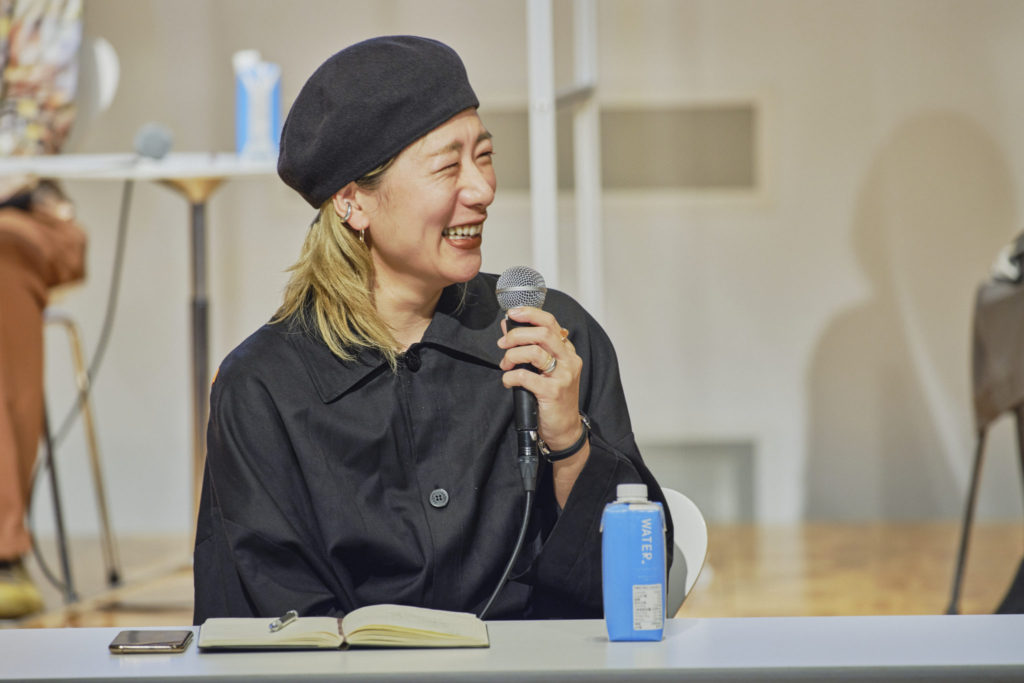
Photographed by Kozo Kaneda
Session 2: Guest Presentations “Around the World: Supporting art exhibitions and artists’ global activities”
Mohri Yuko (Artist, participated in the Sao Paulo Biennale 2021)
Yamashiro Chikako (Artist, participated in the Seoul Mediacity Biennale 2021)
Exhibition grantees in FY 2021 were Mohri Yuko, who was invited to participated in the Sao Paulo Biennale 2021, and Yamashiro Chikako, who took part in the Seoul Mediacity Biennale 2021. Both artists joined the symposium to report on their involvement in international art exhibitions during the pandemic.
Sao Paulo Biennale 2021 (Bienal Internacional de Artes de São Paulo 2021: 4 Sep – 5 Dec, 2021)
Mohri Yuko creates sound installations and kinetic sculptures that incorporate elements of their respective environments. She first visited Sao Paulo in late February 2020 for checking out a venue before an exhibition right before the lockdown. She remembers her stay as two precious days of experiencing the natural light-flooded venue designed by architect Oscar Niemeyer, and savoring the atmosphere of Brazilian streets. The Biennale was later pushed back to 2021 due to COVID-19, but Mohri was to participate in a pre-event, for which she eventually created a work without visiting the exhibition site, an unprecedented experience in her career.
Following the curator’s request not to use walls or other forms of partitioning, the new installation, “I Can’t Hear You,” was exhibited utilizing acoustic velocity and the spacious venue’s characteristic properties.
“UNTITLED,” an installation of sound sculptures Mohri made for the main event in 2021, was once again realized remotely, without her having to visit the exhibition site. Created in response to COVID-19, the new work is a meditation on the present reality and the difficulty of communication, as well as invisible forms of energy such as viruses, expressed through the distorted sounds of various sequences and voices played from three speakers. “In the end, I took up the challenge to create two new pieces, regardless of the fact that I had to work from a remote place,” Mohri said.
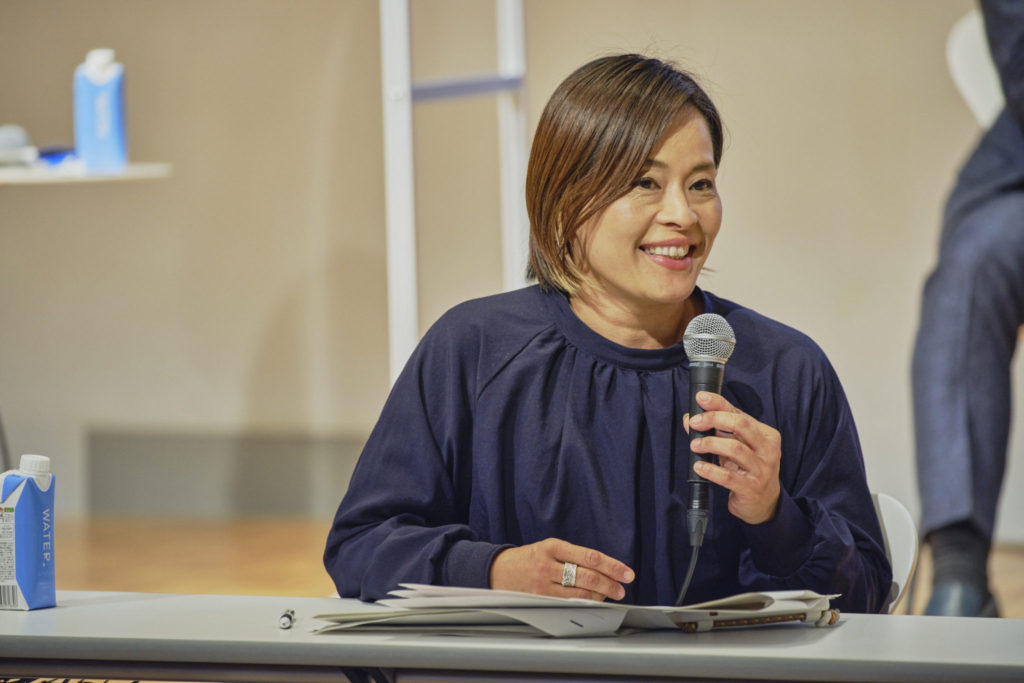
Photographed by Kozo Kaneda
Seoul Mediacity Biennale 2021 (8 Sep – 21 Nov, 2021)
Seoul Mediacity Biennale 2021, in which Yamashiro Chikako participated, had to be postponed as well, and eventually ran from September 8 until November 21, 2021. The overarching theme, “One Escape at a Time,” was intended as a reference to escapism, but curiously enough, proved to coincide with the developments of the coronavirus pandemic. Yamashiro presented the video installation “Chinbin Western—Representation of the Family,” which she originally unveiled in 2019 at an exhibition at the National Art Center, Tokyo. When she created the work back in 2019, Yamashiro was pregnant, and ended up putting the exhibit together remotely, as she was no longer able to board an airplane near her due date. The artist explained that the work was thus, in a sense, already ‘packaged’ for exhibition without her presence at the venue, making it a natural choice for the Seoul show.
The postponement also brought along cuts in the Biennale organizers’ budget, and cutting down costs at the expense of quality became an issue. On the request of Yamashiro, who didn’t want to diminish the quality of her work by cutting down costs, engineers in Seoul suggested equipment, and via Zoom meetings between Korean and Japanese engineers, the exhibit was eventually completed to everyone’s. While the interactive element of the installation had to be left out, Yamashiro expressed her gratitude for being able to realize the work at all, as it might have been canceled altogether without the support she received for this exhibition.
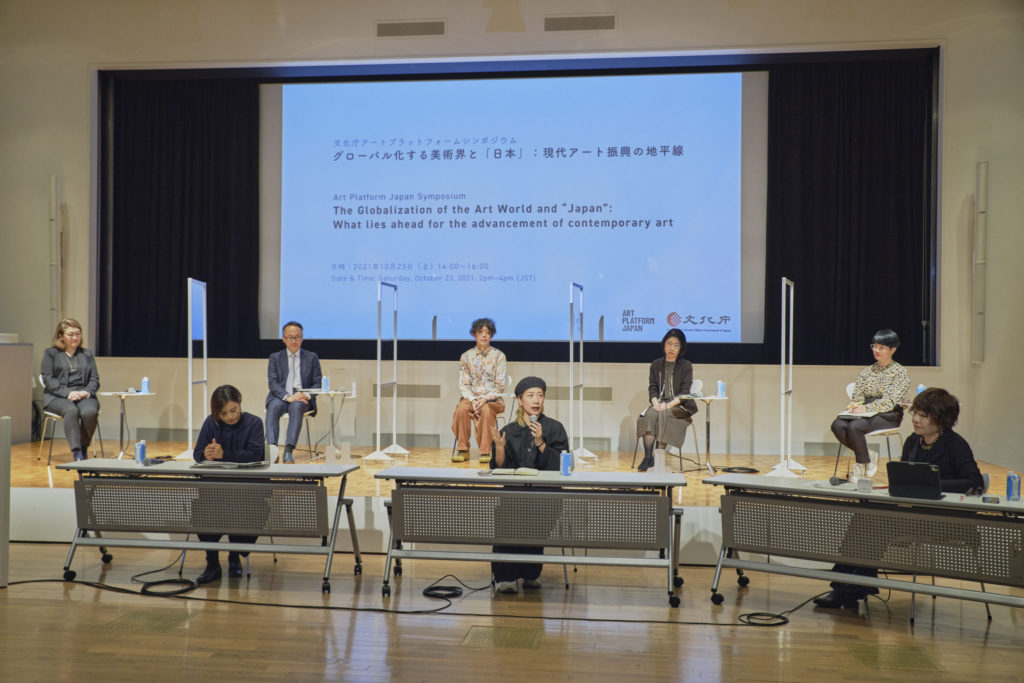
Photographed by Kozo Kaneda
Session 3: Panel Discussion, Q&A
Moderator: Kataoka Mami (Director of the Mori Art Museum, Chair of the Contemporary Art Committee Japan)
Panelists:
Uematsu Yuka (Chief Curator at The National Museum of Art, Osaka; Vice Chair of the Contemporary Art Committee Japan)
Kajiya Kenji (Professor at the Graduate School of Arts and Sciences, The University of Tokyo)
Nariai Hajime (Curator at The National Museum of Modern Art, Tokyo)
Kawaguchi Masako (Head of the Research Library, The National Museum of Western Art)
Odate Natsuko (Arts Commons Tokyo & Yoshiko Isshiki Office)
Mohri Yuko (Artist, participated in the Sao Paulo Biennale 2021)
Yamashiro Chikako (Artist, participated in the Seoul Mediacity Biennale 2021)
Regarding the activities that Kataoka Mami outlined in Session 1, members from individual working groups joined the panelists for a discussion on concrete content, previous achievements, and future issues.
Constructing a global network with visible faces
With the establishment of a network of curators and researchers in Japan and abroad as an ultimate goal, Bunka-cho Contemporary Art Workshops were held in Tokyo in 2018, and again in Osaka and Kyoto in 2019. Uematsu Yuka, who has been involved from the program’s outset, provided an outline of the initiative.
For each workshop, more than twenty exhibition curators from Japan and abroad were invited to discuss a certain topic over three consecutive days. The workshops also included time slots for presentations by artists, and produced various results in the form of projects launched by artists and curators who were brought together at these occasions. In FY 2020, an in-person workshop had to be canceled due to COVID-19. Instead, a webinar series with Japanese and foreign participants was held under the title “Contemporary Art After the Coronavirus and its Ecology.” Topics discussed during the webinar included international communication and exchange, the status of international exhibitions and art itself in the post-COVID-19 age, as well as the development of new forms of criticism.
The next installment of this workshop series is slated to be held at the Fukuoka Asian Art Museum. The workshop will focus on Asia at large, with a program that combines discussions on such topics as Japanese colonization and East Asian and Japanese art, as well as case studies related to art exhibitions in the post-pandemic age. While the specifics will depend on the evolving COVID-19 situation, the idea is to make this an opportunity for as many domestic participants as possible to gather at the venue, share information on planned projects, and exchange ideas regarding ways of communicating from Japan to the rest of the world.
“Face-to-face interaction encourages relationships of mutual trust. Such a network of participants will be helpful for research in the future. What is elemental now is to build a system for networking, which is something people used to do on a private level,” Uematsu said, emphasizing the importance of a familiar network, in which faces can be put to names.
Promoting the translation and contextualization of written materials
A newly formed translation team is another initiative that aims to kindle international interest by making important Japanese texts available in other languages. The translation team selects and translates various written materials, divided into seven topical categories. According to translation team member Kajiya Kenji, the increasing interest in Japanese postwar art can be attributed to a recent worldwide trend that has been reconsidering the Western-centered concept of art and shifting the focus more toward non-Western art. One goal that Art Platform Japan pursues through these translations is thus also to contribute to the creation of a new and different set of values. Up to this point, the team has selected some 30+ texts for translation, 19 of which have been published so far. The target is to select 100 items as candidates for translation within this fiscal year. All of these new translations are being brought to fruition by a team of translators, cross-checkers and English proofreaders/editors. Moreover, about 80 texts that are currently available in English have been selected for publication. These are now being prepared and will be published one by one.
The team further compiled and published a list of characteristic Japanese phrases, and a style guide for translating them into English, which has been favorably received by translators.
(BUNKA-CHO ART PLATFORM JAPAN TRANSLATION PROJECT STYLE GUIDE)
“The ultimate goal is to use the database for creating a review/evaluation system on a yet higher level.” (Kajiya Kenji)
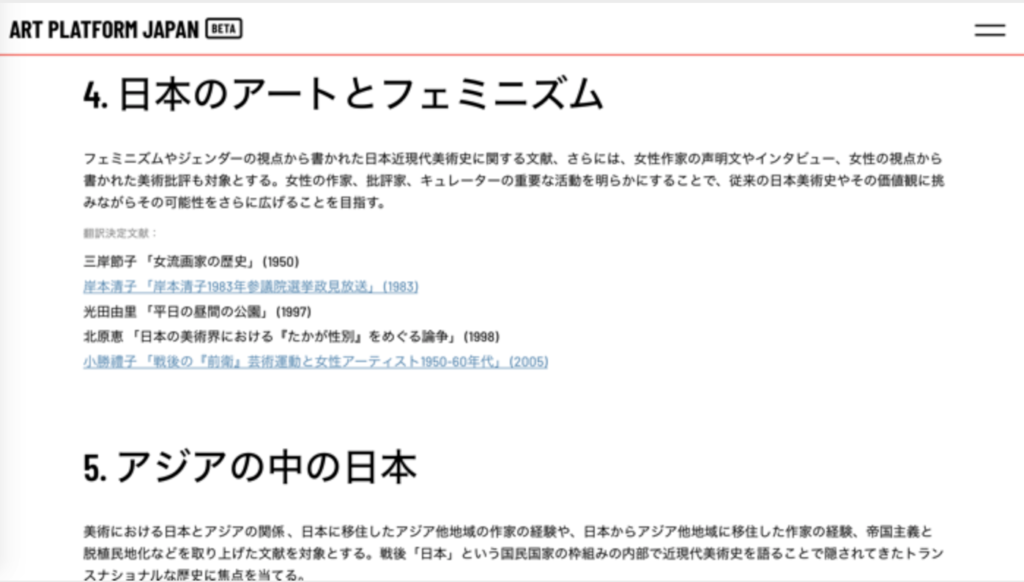
APJ page linking to key texts, divided into seven topical categories: “Collectivism,” “Critics,” “Exhibitions, Events and Sites,” “Feminism and/in Japanese Art,” “Japan in Asia,” “Photography and Media” and “State and Ecology.”
Reinforcing online presence, and the Japanese Museum Collections Search SHŪZŌ
In March 2021, Art Platform Japan was launched as a website providing information related to Japanese contemporary art. SHŪZŌ, a search engine that is part of the website, can be used to access information on collections, artworks and artists catalogued in a database of art museums across Japan.
As of October 21, the database contained a total of 109,351 items, with information on 116 museums and 1,244 artists. This already makes it the largest database of artwork in Japan, and it will continue to grow as a comprehensive archive and vehicle for research data.
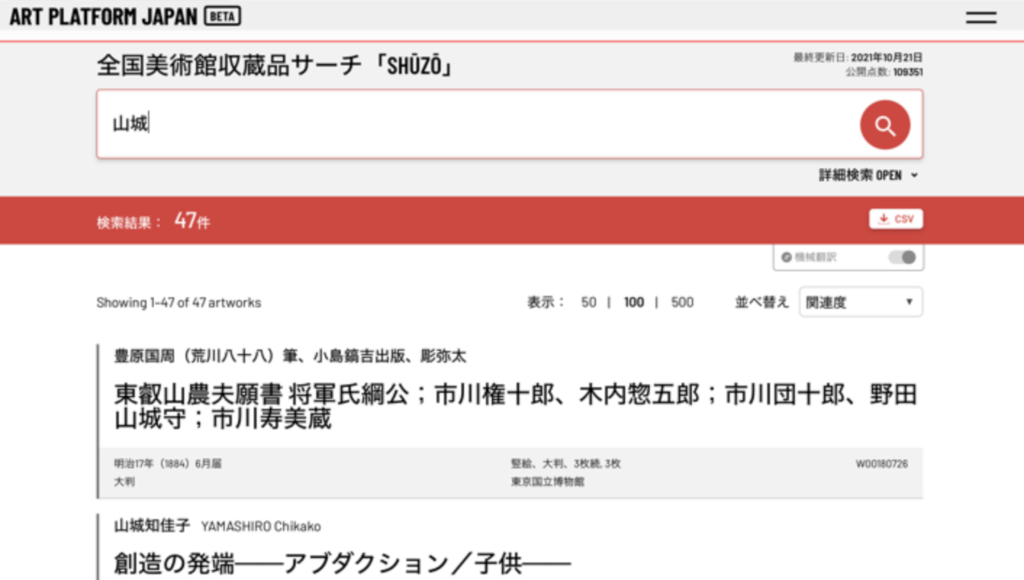
When searching for “Yamashiro,” for example, the system displays a list of national public collections with information related to Yamashiro Chikako, including the artist’s name and titles of her works.
Nariai Hajime, curator at The National Museum of Modern Art, Tokyo, and a member of the project team, made the following comment on collecting and administering various materials related to museum collections, which used to be organized separately up to now: “What we had in mind was to take things that are supposed to be public, and make them public, to be of use not only for experts, but for all kinds of other people with potential ideas.” He added that, with regard to the immediate issue of increasing the number of users, efforts will also be made in the field of public relations.
Kawaguchi Masako, who was involved in the conception of SHŪZŌ alongside Nariai, discussed the system’s association with existing databases. The team is considering a project that would aggregate several databases that are currently operable, including the Bunka-cho’s “Cultural Heritage Online” (https://bunka.nii.ac.jp); a database of national cultural assets (https://kunishitei.bunka.go.jp); and Japan Search (https://jpsearch.go.jp), a repository of information on museums, libraries and other interdisciplinary areas. Furthermore, the team is in the process of compiling a list of art galleries across Japan, and a database that offers an overview of exhibitions overseas that showcase Japanese contemporary art.
“While gradually improving the situation regarding information that people could hardly access in the past, our ultimate goal is to function as an essential resource that offers unique information, and that will eventually be used also in the field of education, at university libraries, etc.” (Kawaguchi Masako)
Forms of support demanded from the creating side
Odate Natsuko, who is involved in the management of artists, shared some perspective from the side of the creators.
“Artists today tend to collaborate with others rather than working alone, and often create work based on preliminary research of exhibition sites, for example. While expanding available resources in the form of websites, we also need to set up a system for providing information to artists coming to Japan from overseas.” She concluded that “nothing happens in the realm of contemporary art when there are no artworks and no artists, so it is of great importance to build and maintain a support system that ensures working space, and provides a stable foundation for their activities.”
When asked what kind of support she would request as an artist, Mohri pointed out that international exhibitions are opportunities for interacting with artists from other countries, and learning about those countries through their work, which is why she would like to see more written material available in English through which other artists might learn more about herself and her Japanese environment/background. She also referred to her new piece incorporating Japanese Kayou-kyoku pop songs that she unveiled at the recent Art Week Tokyo. “I’ve been thinking about ways to communicate the content of Japanese pop songs to foreigners, and arrived at the idea that we may be able to deepen people’s understanding of Japanese culture through international art exhibitions.”
Quite different from Mohri, who usually visits certain locations or countries first and then creates works inspired by that experience, Yamashiro remains based in her hometown, from where she develops her creations on a global scale. There are different types of artists and artworks, and as such, there is no single mode of support that uniformly applies to them all. Yamashiro operates in the realms of art and cinema, participating in international art exhibitions and film festivals alike, so the scope of her work exceeds that of personal project. She requested that backers become aware of the risks that artists have to take in order to create work strong enough to gain international recognition. She stressed that, in order to make ends meet, backers would have to add two digits to the production costs covered at exhibitions—a remark that hit deep.
Devising a program for the creation of a basic infrastructure
Art Platform Japan’s initial five-year program will temporarily end in 2022, to be later resumed by the aforementioned Art Communication Center (tentative name). It will hopefully succeed in improving both the popularity and comprehensiveness of the program through continuous updates, and carry on for a long time.
Kataoka closed the symposium with the following statement:
“Building large museums and hosting art festivals may be ways of presenting results in an easily visible form. However, as some of the basic groundwork has been neglected, international communication hasn’t evolved much up to now. Building databases and translating texts requires steady efforts and a high degree of expertise. These things cannot be easily done in the private sector, so in my view, it is highly meaningful that the Bunka-cho is now engaging in such foundational activities. Networking requires time and effort, but if we continue making steady strides and manage to build a sustainable structure, this work is sure to yield considerable results in the long term.”
It was a symposium with a dense program, from the opening keynote lecture to the discussion. Focusing on the establishment of a solid foundation rather than rough-and-ready events, Art Platform Japan is an initiative that promises to make steady progress with its feet firmly on the ground. The private sector has been channeling great energy into the promotion of the Japanese art market for many years, and if this additional backing from the government contributes to the establishment of “a virtuous cycle of culture promotion and art markets,” that would be a magnificent outcome. Another hopeful sign was the fact that eight out of the ten panelists were women, including Osaka Eriko, the director of the National Art Center, Tokyo, who delivered the opening remarks.
Art is something that inspires the creation of new values, and the symposium was a prime demonstration of how art is sustained by the diversity of players in the field.
Bunka-cho Art Platform Japan Symposium
The Globalization of the Art World and “Japan”: What lies ahead for the advancement of contemporary art
Archive material:
INFORMATION
Bunka-cho Art Platform Japan Symposium
The Globalization of the Art World and “Japan”: What lies ahead for the advancement of contemporary art
Date: 2021.10.23
Venue: Hall, The National Art Center, Tokyo
Organized by Agency for Cultural Affairs


